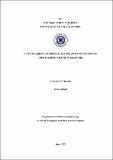Please use this identifier to cite or link to this item:
http://hdl.handle.net/11547/10614| Title: | U-NET BACKBONE ARCHITECTURES FOR 3D SEGMENTATION OF HIPPOCAMPUS VOLUME IN BRAIN MRI |
| Authors: | Achouri, Fella |
| Issue Date: | 2022 |
| Publisher: | ISTANBUL AYDIN UNIVERSITY INSTITUTE OF SOCIAL SCIENCES |
| Abstract: | The volume of the hippocampus is important in the progression of Alzheimer's disease. To determine Hippocampus volume from 3D Brain MRI data, semantic segmentation approaches have been frequently employed. This research compares the usage of different models as backbones with U-Net architecture for semantic segmentation of the Hippocampus from 3D Brain MRI images. The neural network designs ResNet, SE-ResNet, ResNext, SE-ResNext, and DenseNet were employed as the backbone for the U-Net model. For semantic segmentation of the Hippocampus, the Decathlon 3D Brain MRI images dataset was employed. The data collection contains 260 3D brain MRI pictures, the majority of which were created using 35 MRI slices. An exploratory data analysis was performed, which yielded helpful insights from the dataset; the pixel intensity histogram revealed that the majority of pixels in picture slices are bright, making the segmentation process easier for the model. Images were preprocessed and separated into training and testing sets before using the semantic segmentation model. Because most MRI pictures had variable width, height, and slices, each slice of MRI image was transformed into 64x64 pixels of width and height. The image's empty region has been assigned a 0-pixel value, indicating that the pixel would be black in color. Data augmentation has been performed on the preprocessed dataset to increase the samples in the dataset and to help model generalize in a better way. As loss functions, a combination of dice loss and categorical focused loss was utilized. With a 0.7 threshold, the IOU and F-score metrics were utilized. The U-Net model was trained utilizing many backbones, each of which has an influence on the model's performance and efficiency. SE-ResNet-50 performed best in terms of IOU and F-score metrics for both training and validation sets. Other than that SE-ResNext-50 architecture also provided some good results. |
| URI: | http://hdl.handle.net/11547/10614 |
| Appears in Collections: | Tezler -- Thesis |
Files in This Item:
| File | Description | Size | Format | |
|---|---|---|---|---|
| 10546017.pdf | 1.76 MB | Adobe PDF |  View/Open |
Items in DSpace are protected by copyright, with all rights reserved, unless otherwise indicated.
